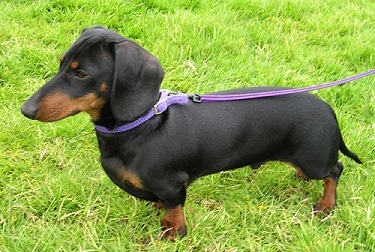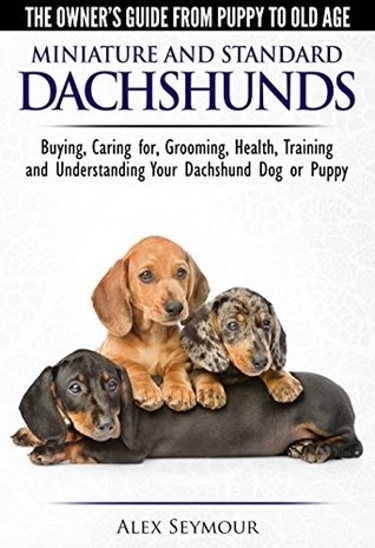
Description: The Dachshund has a strong mix of both hound and terrier characteristics: he has a strong sense of smell, a loud voice and he also has the built-in instinct to search out vermin and rodents. In Germany, where the breed has existed since the early 1600s, the dog was named Dachshund which means “badger dog” and historians believe the original smooth variety evolved from the French Basset.
Later on, crosses with field spaniels created the longhaired type and crosses with terriers created the wirehaired types. Miniature versions of all three coat varieties were then developed by breeding only the smallest specimens from subsequent litters. The breed became popular and was recognized in the late 1800s in Britain and North America. The Dachshund enjoys family life in the country or the city. The combination of excellent tracking abilities and short, compact yet muscular body made the Dachshund an obvious choice for game which liked to burrow or hide in dense thickets.
Height: Miniature Dachshunds are generally under 9″ (23 cm), while the Standard Dachshunds are several inches taller.
Weight: The Miniature Dachshund variety must weigh under 10 lbs (4.5 kg) and the Standard variety usually weighs between 16 and 32 lbs (7-14 kg).
Coat Type: The Dachshund has three coat-types: smooth, longhaired and wirehaired. The Smooth’s coat is short, flat-lying and shiny. The Longhaired’s coat is longer, wavy, and glossy. The Wirehaired’s coat is thick, tight and wiry and is the most weather-resistant of the three types. Colors for all types are solid red, or black with tan markings. The Longhaired and Wirehaired require extra attention for grooming purposes.
Temperament: The Dachshund is intelligent, energetic and brave beyond his means. They make lively, friendly, loyal family pets.
Health Problems: Epilepsy has been demonstrated to have a genetic component in this breed. The Dachshund has a very long back, and is the breed at most risk for disk-related problems (studies have shown that about 25% of Dachshunds will have some disk-related problems in their life). Therefore he should not be allowed to jump from heights, including chairs and beds. He needs moderate, daily exercise to prevent him from becoming overweight, particularly in his senior years. Dachshunds are prone to eye disorders and osteoporosis.
Special Interest: Dachshunds were a favorite of Queen Victoria’s, and she was a serious Dachshund breeder. Because of their fearlessness, Dachshunds have been known to get into trouble which they can’t get out of easily; for example, they can scale a high chain link fence but strand themselves at the top.
Classifications:
AKC: Group 2 – Hounds
ANKC: Group 4 – Hounds
CKC: Group 2 – Hounds
FCI: Group 4 Section 1 Dachshunds
KC: Sporting – Hound Group
UKC: Scenthound Breeds
Kennel.com Recommends Guide to Dachshunds
Guide to Dachshunds
 Kennel.com – Complete Guide to Dogs The Dog Lovers Guide
Kennel.com – Complete Guide to Dogs The Dog Lovers Guide